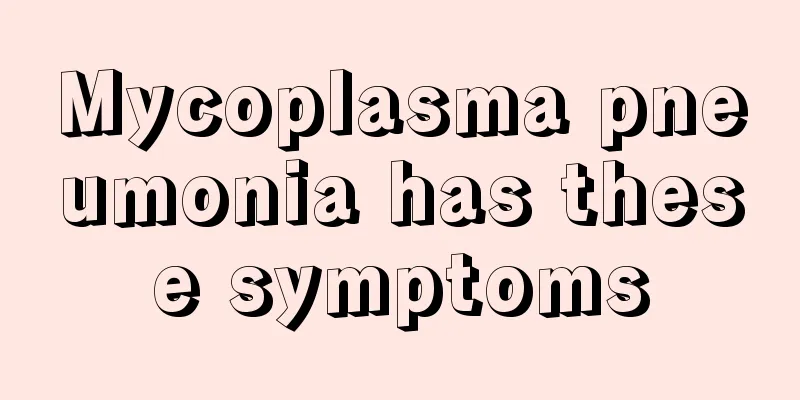Mycoplasma pneumonia has these symptoms

|
Mycoplasma pneumonia is a common viral disease that is generally transmitted through the respiratory tract, such as saliva, nasal secretions, etc. Once infected, the patient will experience general discomfort, fatigue, headache, high fever of around 39 degrees, accompanied by dry cough, sore throat, muscle aches, etc. 1. Causes The pathogen is Mycoplasma pneumoniae, a microorganism between bacteria and viruses, without a cell wall structure, facultative anaerobic, and the smallest microorganism that can live independently. It is mainly transmitted through the respiratory tract. Healthy people are infected by inhaling oral and nasal secretions emitted when patients cough or sneeze. Pathogens usually exist between the ciliated epithelium of the respiratory tract and do not invade the lung parenchyma. They adsorb to the surface of the host respiratory epithelial cells through the neuraminic acid receptor sites on the cell membrane, inhibit ciliary activity and destroy epithelial cells. 2. Clinical manifestations The onset is slow, with an incubation period of about 2 to 3 weeks. Symptoms at the beginning include general discomfort, fatigue, and headache. Fever develops 2 to 3 days later, with the temperature often reaching around 39°C and lasting for 1 to 3 weeks, and may be accompanied by sore throat and muscle aches. Cough is the most prominent symptom of this disease, which usually begins 2 to 3 days after the onset of the disease. It is a dry cough at first, and then turns into a stubborn and severe cough, often with thick sputum occasionally stained with blood. In a few cases, it may be similar to whooping cough. It can last for 1 to 4 weeks. Pulmonary signs are often subtle or even absent. A few people can hear dry and wet music. However, many of the masses disappeared, so the physical signs were inconsistent with the clinical manifestations such as severe cough and fever, which is one of the characteristics of this disease. Infants and young children have an acute onset, a long course, and more severe conditions, with symptoms such as dyspnea, wheezing, and more prominent wheezing, and more lung rales than older children. Some children may suffer from hemolytic anemia, meningitis, myocarditis, groin, Green-Barry syndrome and other extrapulmonary manifestations. Treatment Early use of appropriate antimicrobial drugs can alleviate symptoms and shorten the course of the disease. The disease is self-limiting and most cases heal on their own without treatment. Macrolide antibiotics are the first choice, such as erythromycin, roxithromycin and azithromycin. Fluoroquinolones such as levofloxacin, gatifloxacin and moxifloxacin, and tetracyclines are also used to treat Mycoplasma pneumoniae pneumonia. The course of treatment is generally 2 to 3 weeks. Because Mycoplasma pneumoniae has no cell wall, antibacterial drugs such as penicillin or cephalosporin are ineffective. For those who suffer from severe choking and coughing, appropriate antitussive drugs should be given. If secondary bacterial infection occurs, targeted antibacterial drugs can be selected for treatment based on sputum etiology examination. The disease is self-limiting, and most cases can heal themselves without treatment. The use of appropriate antibacterial drugs can alleviate symptoms and shorten the course of the disease. Erythromycin is the first choice for treatment, but tetracyclic antibiotics can also be used. Early use of appropriate antibiotics can alleviate symptoms and shorten the course of the disease to 7 to 10 days. |
<<: Do you know the side effects of laser freckle removal?
>>: Common home recipes for skin care and acne treatment
Recommend
Why do fat particles grow
In people's daily lives, there are some speci...
What causes subcutaneous bleeding? Causes of subcutaneous bleeding
Many people have had this experience: a purple sp...
Eating crabs and pumpkins will cause poisoning
Pumpkin and crab are both things we eat frequentl...
What should not be eaten after laser freckle removal
For female friends who love beauty, you should ha...
Can you get melanoma in your twenties?
Melanoma can also occur in your 20s and has littl...
Five tips to keep away sleepiness in summer
As the saying goes, "Spring makes you sleepy...
What are the preventive measures to prevent esophageal cancer?
Esophageal cancer is a common tumor. The incidenc...
What are the nursing methods for lung cancer? Using 3 methods to care for lung cancer patients is the most reasonable
People of all ages are likely to get lung cancer,...
What are the symptoms and precursors of lung cancer? Know the 4 symptoms of lung cancer early
Do you often have chest pain and sometimes hoarse...
Does your face feel like frosted?
Many people envy a smooth and tender face. Some p...
How to deal with tooth root splitting
Toothache is very uncomfortable. If the pain last...
What does neurology mainly examine?
Many people with mental illnesses will be advised...
What are the side effects of donkey-hide gelatin?
The famous Chinese medicine donkey-hide gelatin i...
What are the harms of x-rays to the body
X-rays are a type of radiation we are exposed to ...
Experts explain the causes that may lead to brain cancer
Because brain cancer occurs in a very special loc...









